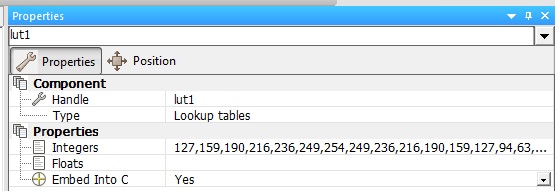Difference between revisions of "Component: Lookup tables (Utility)"
| Line 161: | Line 161: | ||
[[File:LUTdata.jpg]] | [[File:LUTdata.jpg]] | ||
| + | |||
| + | |||
| Line 220: | Line 222: | ||
| width="90%" style="border-top: 2px solid #000;" | ''Return'' | | width="90%" style="border-top: 2px solid #000;" | ''Return'' | ||
|} | |} | ||
| − | |||
| − | |||
Revision as of 12:20, 3 February 2023
| Author | Matrix Ltd |
| Version | 1.7 |
| Category | Utility |
Contents
Lookup tables component
A lookup-table component allowing an easy way to place arrays of static data into ROM memory. The LUT data is accessed directly allowing very low overhead when collecting the data.
Component Source Code
Please click here to download the component source project: FC_Comp_Source_temp/LUT.fcfx
Please click here to view the component source code (Beta): FC_Comp_Source_temp/LUT.fcfx
Detailed description
No detailed description exists yet for this component
Examples
A look up table component is useful when including data into a program which may not be linear and therefore hard to calculate.
One example of this is a sine wave or working out a temperature based on the resistance of a thermistor.
For a simple example lets say we want to store a sine wave on board the microcontroller.
First of all we use Excel to generate the data for a sine wave to do this we work out the angles in degrees we want to reproduce, then convert the degrees to radians and then generate the Sine wave for the angle. the angle returned will be between -1 and 1 so we need to convert this to fit into the microcontroller's memory. The most efficient way is to store the value as a byte which means scaling up the output to 0 - 255 and removing the real portion of the number to give integer values.
Then using the file -> Save as menu in Excel we can export the data as a raw .CSV file.
The line in the CSV file we are interested in is the Integer Offset Data. We can then copy and paste this data into the integer property of the look up table component.
In this example Flowcode file we display the LUT data onto a graphical LCD display
![]() LUT
Here is what you should expect to see on the glcd after running the simulation.
LUT
Here is what you should expect to see on the glcd after running the simulation.
Macro reference
GetFloat
| GetFloat | |
| Gets a float from the LUT | |
| Index | |
| Return | |
GetInt
| GetInt | |
| Gets an integer from the LUT | |
| Index | |
| Return | |
GetLUTCount
| GetLUTCount | |
| Gets the number of individual data entries stored in the LUT. | |
| Return | |

